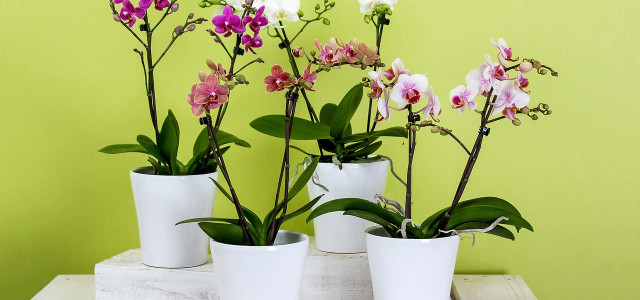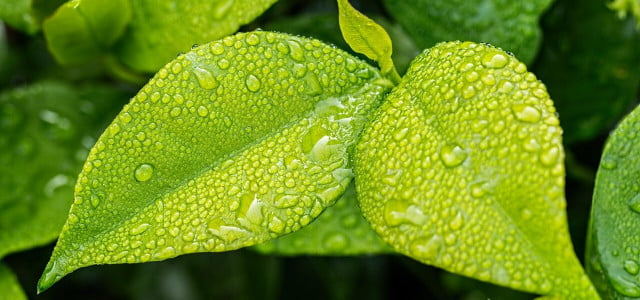Orchids require very different and more specific care than other plants, and can therefore be confusing. Follow these tips to learn how to water your orchid.
Orchids have a reputation for being a finicky plant that is difficult to care for, but are easy to care for once you understand what they require. There are over 25,000 individual species within the orchid family, so if you don’t have luck with one variety, you can try another. Read on to learn how to water orchids, and tips to keep your orchids thriving.
How to Water Your Orchids
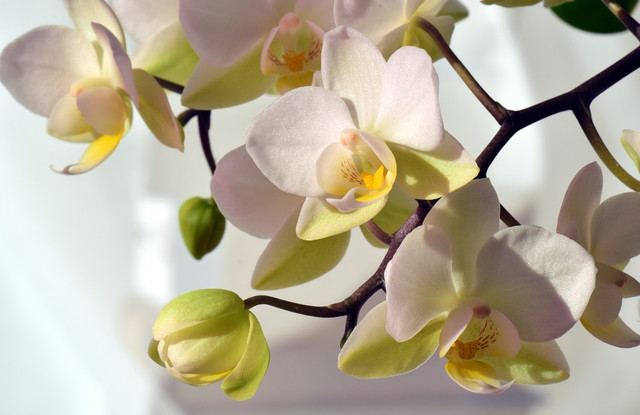


(Foto: CC0 / Pixabay / ulleo)
Orchids grown as indoor houseplants are often epiphytes, meaning they cling to trees or grown on stones in nature. That means that the rooting system is much different than a typical houseplant – and the watering routine needs to reflect that. Orchids need water to thrive, but they collect it inside their roots so you don’t need to water your orchid again until the soil is dry.
Orchid roots have a thin membrane called velamen that helps to soak up the water. You can use these as a visual aid to know when it’s time to water. When the roots look white or silver, the velamen is dry and your orchid needs a drink. Properly hydrated velamen is green or mottled looking, depending on the variety. Use the following tips on how to water orchids:
- Water in the morning: no matter which type of orchid you have, you should only water them in the morning. This gives the plant time to dry out before the evening, which reduces the risk of bacterial and fungal diseases.
- Allow the plant to dry out between waterings: orchids don’t like to be sitting in water, so wait until it’s dry before watering again.
- Water thoroughly: don’t be afraid to dunk the entire pot and plant in a sink or bucket full of water and leave it there for a while. The goal is to saturate the velamen completely – you want tiny droplets of water hanging on the roots once you’re done.
- Check your water: depending on the tap water in your area, it may contain high amounts of minerals. If you notice deposits forming on your plants, it’s a good idea to reevaluate the water you’re using and try and find an alternative solution.
Tip: Most orchids would rather be under-watered than overwatered. If kept wet, orchids will eventually rot and die.
Caring for Orchids: Tips & Tricks
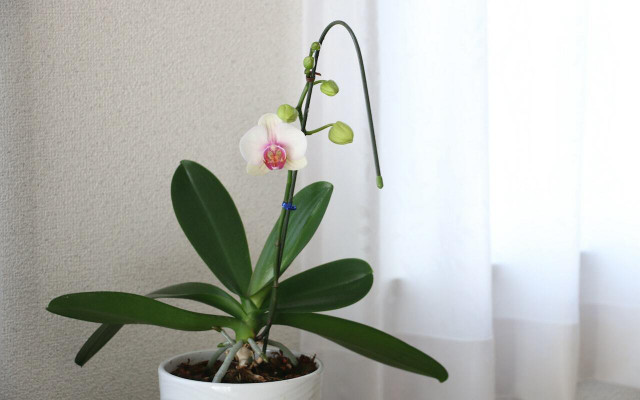


(Foto: CC0 / Unsplash / Zhisheng Deng)
Learning how to water orchids is only one part of orchid care – they need attention in other areas in order to thrive.
- Have the right “soil” – orchids do not grow well in regular dirt/potting soil as the dirt will smother the roots. Instead, orchids require a lot of drainage – so you will need the correct “soil”. Orchids generally need bark, moss, rocks, sand, or charcoal as a base in which to grow. A basic mix of these will suffice, but different orchids need different “soil” so be sure to explore which type you have before purchasing the soil.
- Proper sunlight – orchids need the right amount sunshine, so be sure to place them in a spot with indirect light, such as an east or south facing room/window. Too much light can scorch the leaves, so be sure to monitor your orchid to find the right balance. Since there are so many varieties of orchids, it’s also important to learn which kind you have and how much sun it needs, as this can vary between types.
- Fertilizer – orchids need a weekly or bi-weekly diluted fertilizing, and this should be a specific orchid fertilizer as the average planting fertilizers have ingredients that an orchid cannot maintain and it could harm the plant. You can also use try using homemade plant food. Fertilize when the plant is producing new growth, but discontinue when the plants go dormant.
- Temperature matters – orchids are used to the changing seasons and temperature changes, so being inside at a fairly consistent temperature can be a bit tricky. Different varieties prefer different temperatures, as well, so be sure to look up your specific orchid. The general rule is, temperature at night needs to be about 15 degrees Fahrenheit cooler than during the day for the proper care.
Orchids may outgrow their pots and need to be repotted. If you can see the roots above the pot, it’s time for a larger one. The soil that orchids grow in can break down with time, which does not allow the proper drainage of water. Some orchids need to repotted in specific times of the year or immediately after flowering – make sure to find out what type you have to properly adapt the orchids home. Repotting an orchid also requires special care with the water temperature and tools that you use.
Follow these steps when repotting your orchid:
- Mix together a solution of ½ cup vinegar and 1 gallon of water and clean all of your tools and the new orchid pot you will use with the solution. Orchids are very sensitive to bacteria and can be harmed if you have not cleaned the area. Wash your hands thoroughly before repotting or wear clean gloves.
- Place the new orchid soil inside a large bowl and cover the soil with boiling water. Once the temperature has cooled, drain the soil and place it inside the new pot.
- Gently remove the orchid from its old pot, and pull the roots slightly away from the plant. Check the roots for brown or rot, removing these with scissors. Place inside the new pot with the potting soil.
- Using a chopstick or small tool to push the soil in between the roots of the orchid.
- Mist the plant everyday until you can see new roots. It is often suggested to use clear pots for this reason.
Proper Care and Water for Outdoor Orchids
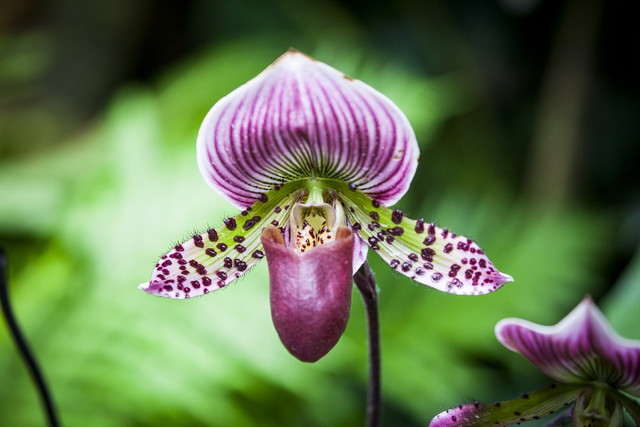


(Foto: CC0 / Pixabay / DaFranzos)
Since orchids are sensitive to temperature and seasonal shifts, not everyone will be able to keep orchids outside all year round. The type of orchid is key, so make sure you know what type of orchid you have before trying to place it outside. If you have mild weather, you can plant your orchids outside. Follow these tips for proper care for outdoor orchids:
- No frost: if you are planning to put the orchid outside permanently, make sure that the risk of frost has passed completely before attempting to plant them.
- Proper and gradual sunlight: orchids generally need indirect light, so look for a shade and sun mixed spot in your garden. If the orchid will live permanently outside, you can mount them on trees to give them the proper sunlight balance. If you are moving them outside within their pot, gradually bring the sunlight amount up by moving the plant into gradually more bright spots.
- Proper bug care: outdoor orchids are much more at risk for bugs and other critters like squirrels to disrupt their growing. Raise the orchid off the ground and spray with a mix of a natural pesticide, such as dish soap, water, and horticulture oil or neem oil or an insecticide to keep the bugs away.
- Humidity: orchids need a relatively high amount of humidity to grow, so make sure the plants are near each other or near other plants so that the humidity doesn’t disappear instantly and dry out the roots.
- Temperature: as the type of orchid will dictate the proper temperature for outdoor planting, make sure you know what kind you have before planting. Generally, many orchids will grow in temperatures from 40-90 degrees Fahrenheit.
- Watering: again this depends on the type of orchid and the temperature outside, but always make sure that the roots have circulation of air flow and are not over watered. Check the soil around the orchid for dryness, and only water when dry.
Whether you plant your orchid indoors or out, these tips will help keep them thriving, and always make sure to find out exactly what type of orchid you have before planting.
Read on:
- Best Indoor Hanging Plants to Decorate Your Home
- 11 Flowers for Bees: Turn Your Garden or Balcony Into a Bee Paradise
- How to Lower the Humidity in Your House: Tips for Avoiding Mold
Do you like this post?






